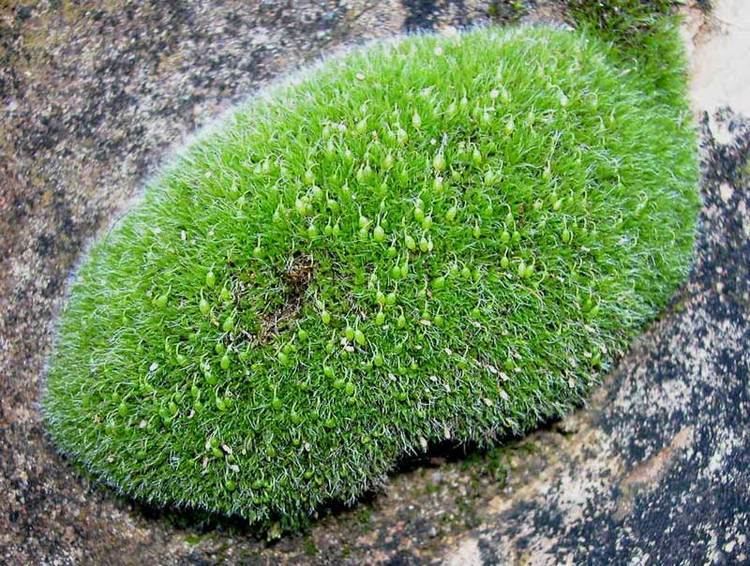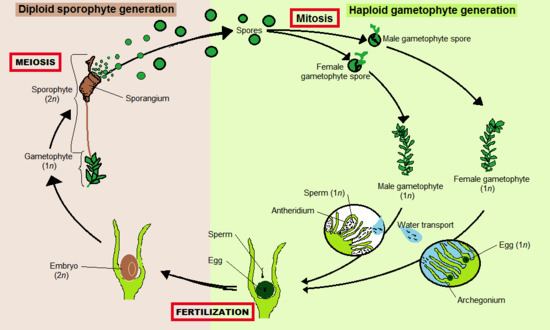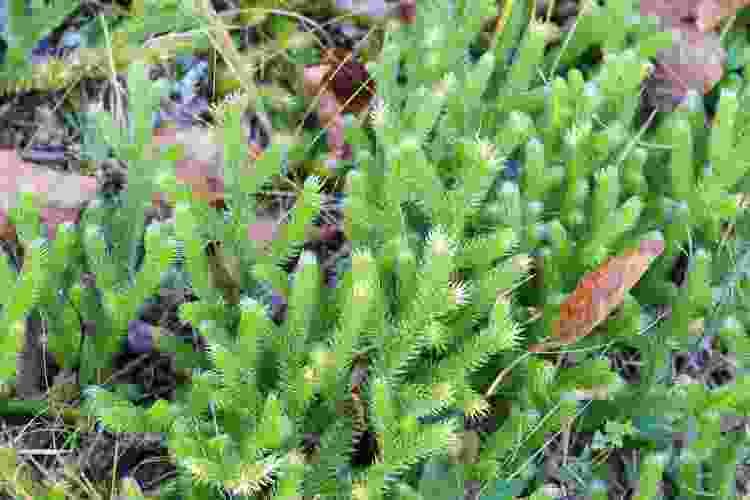 | ||
Representative species Java moss, Polytrichum commune, Pincushion moss, Horn calcareous moss, Bank haircap | ||
Bryophytes
Bryophyte is a traditional name used to refer to all embryophytes (land plants) that are non-vascular plants, namely the mosses, hornworts, and liverworts. The defining features of bryophytes are that their life cycles are dominated by the gametophyte stage, that their sporophytes are unbranched and that they do not have a true vascular tissue containing lignin, although some have specialized tissues for the transport of water. Bryophytes are usually considered to be a paraphyletic group and not a natural (monophyletic) group, although some studies have produced contrary results. Regardless of their status, the name is convenient and remains in use as an informal collective term. Bryophytes produce enclosed reproductive structures (gametangia and sporangia), but they produce neither flowers nor seeds, reproducing via spores. The term "bryophyte" comes from Greek βρύον, bryon, "tree-moss, oyster-green" + φυτόν – phyton "plant".
Contents
- Bryophytes
- Bryophytes the secret plants that surround us
- Life cycle
- Sexuality
- Classification and phylogeny
- Paraphyletic view
- Other views
- Evolution
- Comparative morphology
- References

Bryophytes the secret plants that surround us
Life cycle

Like all land plants (embryophytes), bryophytes have life cycles with alternation of generations. In each cycle, a haploid gametophyte, each of whose cells contains a fixed number of unpaired chromosomes, alternates with a diploid sporophyte, whose cell contain two sets of paired chromosomes. Gametophytes produce haploid sperm and eggs which fuse to form diploid zygotes that grow into sporophytes. Sporophytes produce haploid spores by meiosis, that grow into gametophytes.

Bryophytes are gametophyte dominant, meaning that the more prominent, longer-lived plant is the haploid gametophyte. The diploid sporophytes appear only occasionally and remain attached to and nutritionally dependent on the gametophyte. In bryophytes, the sporophytes are always unbranched and produce a single sporangium (spore producing capsule).

Liverworts, mosses and hornworts spend most of their lives as gametophytes. Gametangia (gamete-producing organs), archegonia and antheridia, are produced on the gametophytes, sometimes at the tips of shoots, in the axils of leaves or hidden under thalli. Some bryophytes, such as the liverwort Marchantia, create elaborate structures to bear the gametangia that are called gametangiophores. Sperm are flagellated and must swim from the antheridia that produce them to archegonia which may be on a different plant. Arthropods may assist in transfer of sperm.

Fertilized eggs become zygotes, which develop into sporophyte embryos inside the archegonia. Mature sporophytes remain attached to the gametophyte. They consist of a stalk called a Seta and a single sporangium or capsule. Inside the sporangium, haploid spores are produced by meiosis. These are dispersed, most commonly by wind, and if they land in a suitable environment can develop into a new gametophyte. Thus bryophytes disperse by a combination of swimming sperm and spores, in a manner similar to lycophytes, ferns and other cryptogams.
Sexuality
The arrangement of antheridia and archegonia on an individual bryophyte plant is usually constant within a species, although in some species it may depend on environmental conditions. The main division is between species in which the antheridia and archegonia occur on the same plant and those in which they occur on different plants. The term monoicous may be used where antheridia and archegonia occur on the same gametophyte and the term dioicous where they occur on different gametophytes.
In seed plants, "monoecious" is used where flowers with anthers (microsporangia) and flowers with ovules (megasporangia) occur on the same sporophyte and "dioecious" where they occur on different sporophytes. These terms occasionally may be used instead of "monoicous" and "dioicous" to describe bryophyte gametophytes. "Monoecious" and "monoicous" are both derived from the Greek for "one house", "dioecious" and "dioicous" from the Greek for two houses. The use of the "oicy" terminology is said to have the advantage of emphasizing the difference between the gametophyte sexuality of bryophytes and the sporophyte sexuality of seed plants.
Monoicous plants are necessarily bisexual (or hermaphroditic), meaning that the same plant has both sexes. The exact arrangement of the antheridia and archegonia in monoicous plants varies. They may be borne on different shoots (autoicous or autoecious), on the same shoot but not together in a common structure (paroicous or paroecious), or together in a common "inflorescence" (synoicous or synoecious). Dioicous plants are unisexual, meaning that the same plant has only one sex. All four patterns (autoicous, paroicous, synoicous and dioicous) occur in species of the moss genus Bryum.
Classification and phylogeny
Traditionally, all living land plants without vascular tissues were classified in a single taxonomic group, often a division (or phylum). More recently, phylogenetic research has questioned whether the bryophytes form a monophyletic group and thus whether they should form a single taxon. Although a 2005 study supported the traditional view that the bryophytes form a monophyletic group, by 2010 a broad consensus had emerged among systematists that bryophytes as a whole are not a natural group (i.e., are paraphyletic), although each of the three extant (living) groups is monophyletic.
The three bryophyte clades are the divisions Marchantiophyta (liverworts), Bryophyta (mosses) and Anthocerotophyta (hornworts). The vascular plants or tracheophytes form a fourth, unranked clade of land plants called the "Polysporangiophyta". In this analysis, hornworts are sister to vascular plants and liverworts are sister to all other land plants, including the hornworts and mosses. Phylogenetic studies continue to produce conflicting results. In particular those based on gene sequences suggest the bryophytes are paraphyletic, whereas those based on the amino acid translations of the same genes suggest they are monophyletic. A 2014 study concluded that composition biases were responsible for these differences and that the bryophytes are monophyletic. The issue remains unresolved.
Paraphyletic view
When extinct plants are taken into account, the picture is slightly altered. Some extinct land plants, such as the horneophytes, are not bryophytes, but also are not vascular plants because, like bryophytes, they do not have true vascular tissue. A different distinction is needed. In bryophytes, the sporophyte is a simple unbranched structure with a single spore-forming organ (sporangium). In all other land plants, the polysporangiophytes, the sporophyte is branched and carries many sporangia. It has been argued that this contrast between bryophytes and other land plants is less misleading than the traditional one of non-vascular versus vascular plant, since many mosses have well-developed water-conducting vessels. The contrast is shown in a slightly different cladogram:
The term "bryophyte" thus refers to a grade of lineages defined primarily by what they lack. Compared to other living land plants, they lack vascular tissue containing lignin and branched sporophytes bearing multiple sporangia. The prominence of the gametophyte in the life cycle is also a shared feature of the three bryophyte lineages (extant vascular plants are all sporophyte dominant).
Other views
An alternative phylogeny, based on amino acids rather than genes, shows bryophytes as a monophyletic group:
If this phylogeny proves correct, then the complex sporophyte of living vascular plants might have evolved independently of the simpler unbranched sporophyte present in bryophytes. Other studies suggest a monophyletic group comprising liverworts and mosses, with hornworts being sister to vascular plants.
Evolution
Bryophytes are the oldest of all lineages of land plants and are believed to be a vital link in the migration of plants from aquatic environments onto land. A number of physical features link bryophytes to both land plants and aquatic plants. Two distinct adaptations have helped to make the move from water to land possible and forged the way for plants to colonize the Earth's terrestrial environments. A waxy cuticle covering the soft tissue of the plant provides protection and prevents desiccation of the plant's tissues. The development of gametangia provided further protection specifically for gametes.
They also have embryonic development which is a significant adaptation seen in land plants and not green algae. Connections to their aquatic ancestry are also evident through their dependence on water for reproduction and survival. A thin layer of water is required on the surface of the plant to enable the movement of sperm between gametophytes and the fertilization of an egg.
Comparative morphology
Summary of the morphological characteristics of the gametophytes of the three groups of bryophytes:
Summary of the morphological characteristics of the sporophytes of the three groups of bryophytes:
